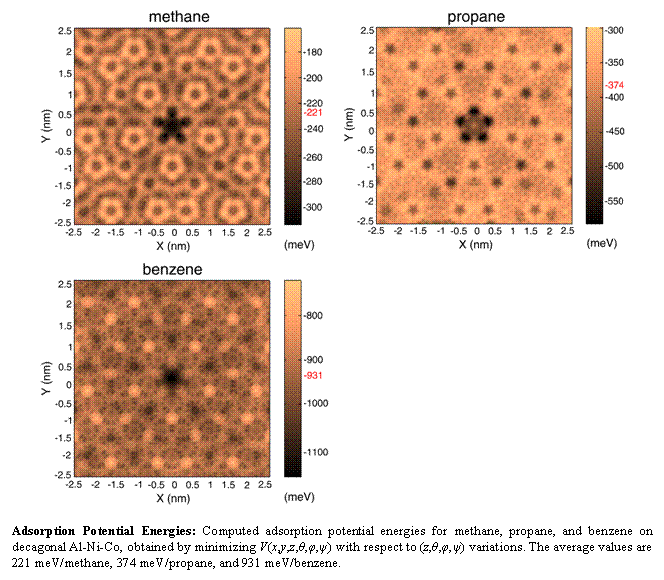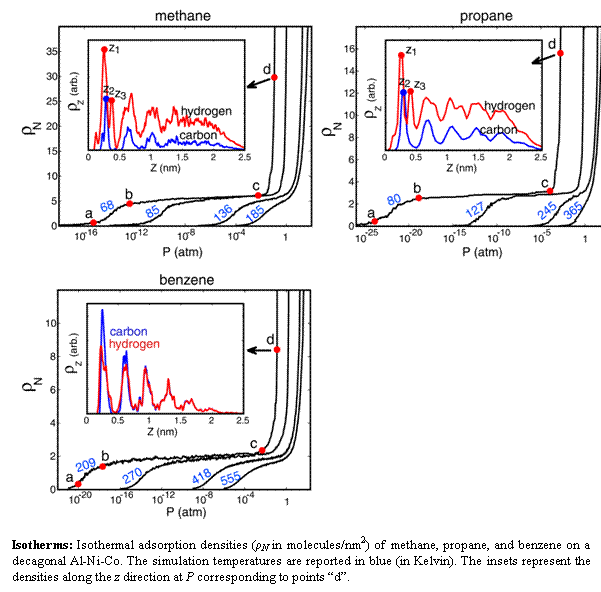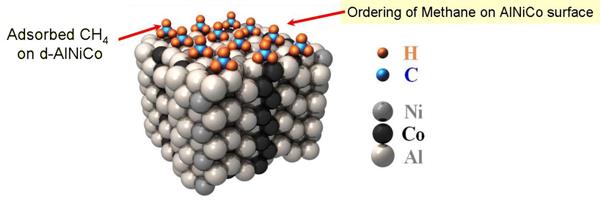Reports: G5
45814-G5 Is Superlubrication Possible in Engines? Characterization of the Adsorption of Hydrocarbons on Quasicrystal Surfaces
Research
The low-friction properties of quasicrystals in ambient conditions coupled with their high hardness and oxidation resistance led to the development of applications of quasicrystal coatings, for instance on machine parts, cutting blades, and non-stick frying pans. In such practical applications, hydrocarbons are commonly used as a lubricant. Superlubricity is the name given to the phenomenon in which two parallel single crystal surfaces slide over each other with vanishingly small friction because their structures are incommensurate. Although there are other factors in these systems, aside from incommensurability, that affect the friction, superlubricity may play a major role in the friction of quasicrystals because of their aperiodic structures. If superlubricity plays a role, then the lubricant in such a situation must not remove or reduce that effect. Similarly, if reduced phonon coupling is important, then this must be maintained with the lubricant. Therefore it is desirable to have a good understanding of how gases, hydrocarbons in particular, interact with quasicrystal surfaces.
In this ACS sponsored research, we have addressed the fundamental issues that affect the growth and structural properties of gases on a quasicrystal surface. We have devised theoretical studies of the adsorption and growth of rare gases and hydrocarbons on such system.
[A] By parameterizing through the Grand Canonical Monte Carlo method (GCMC) the evolution of topological order in Xe Films on decagonal Al-Ni-Co surface we have discovered a 5- to 6-fold first order symmetry transition, which explains previous experimental results.
[B] We have constructed a phenomenological rule predicting the existence of this transition as function of size mismatch between the contaminant atoms (lubricants) and the surface. Occurrence of the transition increases friction.
[C] By calculating Embedded Atom Method interaction between simple hydrocarbons and the decagonal Al-Ni-Co surfaces, we have found that the transition, present for benzene and absent for methane, corroborates the phenomenological rule based on adsorbate-substrate size mismatch.
In the Embedded-Atom Method (EAM) formalism, the total energy of a system is written as
where the many-body term Fi represents the energy required to embed the i-atom in a particular position r having total charge density ρ(r), and the term Φ accounts for the pair interaction. The total charge density in the position of i-atom is taken as the sum of atomic charge density from all contributing atoms except the i-atom itself. The potentials are parameterized using natural cubic splines for the embedding energies and the following functionals for the atomic charge densities and pair interactions:
The last equation is the mixing scheme for pair interaction between different types of atoms.
EAM Table. Fitted parameters of the EAM potentials for hydrocarbons adsorption on decagonal Al-Ni-Co. The embedding energy functions are taken as natural cubic splines, with knots expressed in (ρ, Fy), where ρ is in Ǻ-3 and Fy is in eV.
|
|
C
|
H
|
Al
|
Co
|
Ni
|
|
ρe (Ǻ-3)
|
0.932
|
1.639
|
0.026
|
0.090
|
0.126
|
|
β
|
5.473
|
2.798
|
7.182
|
5.945
|
5.447
|
|
re (Å)
|
1.240
|
0.740
|
2.700
|
2.280
|
2.150
|
|
D (eV) |
0.116
|
0.224
|
0.034
|
0.037
|
0.039
|
|
α (Ǻ-1) |
2.786
|
3.156
|
1.740
|
3.636
|
3.198
|
|
ro (Å)
|
1.478
|
1.076
|
2.938
|
2.730
|
2.731
|
|
Z/ZC |
1
|
0.532
|
0.989
|
1.115
|
1.258
|
|
Z/ZH
|
|
1
|
0.857
|
1.140
|
0.850
|
|
Z/ZAl |
|
|
1
|
0.370
|
0.498
|
|
Z/ZCo |
|
|
|
1
|
0.970
|
|
knot1
|
0,0
|
0,0
|
0,0
|
0,0
|
0,0
|
|
knot2
|
0.353, -3.860
|
1.037, -3.475
|
0.079, -3.038
|
0.217, -4.216
|
0.252, -4.354
|
|
knot3 |
0.519, -5.429
|
1.527, -3.974
|
0.108, -3.296
|
0.358,- 6.713
|
0.327, -4.901
|
|
knot4 |
0.746, -6.254
|
1.797, -3.797
|
0.507, -4.546
|
0.774, -6.972
|
0.574, -5.370
|
|
knot5 |
1.033, -7.443
|
1.899, -3.744
|
0.893, -3.903
|
1.439, -6.665
|
1.032, -5.752
|
|
knot6 |
1.824, -7.988
|
2.200, -3.674
|
1.408, -3.971
|
1.635, -6.270
|
1.354, -5.609
|
|
knot7 |
2.200, -7.264
|
-
|
2.200, -3.141
|
2.200, -4.639
|
2.200, -4.574
|

Table. Summary of adsorbed noble gases and selected hydrocarbons on the QC that undergo a first-order fivefold to sixfold structural transition and those that do not. The size mismatch is defined as dm ≡ (k · σgg - λr)/λr , where k = 0.944 is the distance between rows in a close-packed plane of a bulk LJ gas, λr is the characteristic spacing of the QC, determined from the momentum transfer analysis of LEED patterns. We have transition when dm>0.
Adsorption Potential Energies: Computed adsorption potential energies for methane, propane, and benzene on decagonal Al-Ni-Co, obtained by minimizing V(x,y,z,θ,φ,ψ) with respect to (z,θ,φ,ψ) variations. The average values are 221 meV/methane, 374 meV/propane, and 931 meV/benzene.
Isotherms: Isothermal adsorption densities (ρN in molecules/nm2) of methane, propane, and benzene on a decagonal Al-Ni-Co. The simulation temperatures are reported in blue (in Kelvin). The insets represent the densities along the z direction at P corresponding to points ÂdÂ.
Impact of the research
work
has revealed novel understanding of the roles of the adsorbate-size
and surface-corrugation on the topological order of the adsorbed film. When the
5- to 6-fold transition is missing, the monolayer does not form a periodic
structure and the adsorbed surface does not change the commensurability of the
system. The quasicrystalline film of methane that we predict indicates the
potential use of quasicrystals as low-friction coatings in environments where
methane is present. Even though longer alkanes form a
periodic close-packed structures, the commensurability occurs only when their
films are exactly aligned, suggesting that lubricity might still be enhanced
with quasicrystalline coatings. Theoretically,
an internal combustion engine with pistons and cylinders coated with Al-Ni-Co
could work without the help of a lubricant if burning methane as combustible at
medium temperature. Our work has
been published in PRL and JPCM.
Impact of the PI
career
Superlubrication and surface
science is one the research topics of the PI's group. The collaboration with
Dr. Diehl at Broad Impact on the
student education
Wahyu
Setywan was the graduate student working on this
project. This research represents a substantial part of his Ph.D. dissertation.
During his research, Setyawan has learned thermodynamics, surface science, and
computational modeling of adsorption. Our Embedded Atom Method potentials for
Al-Ni-Co have been shared with other scientists working in adsorption and
surface science.









